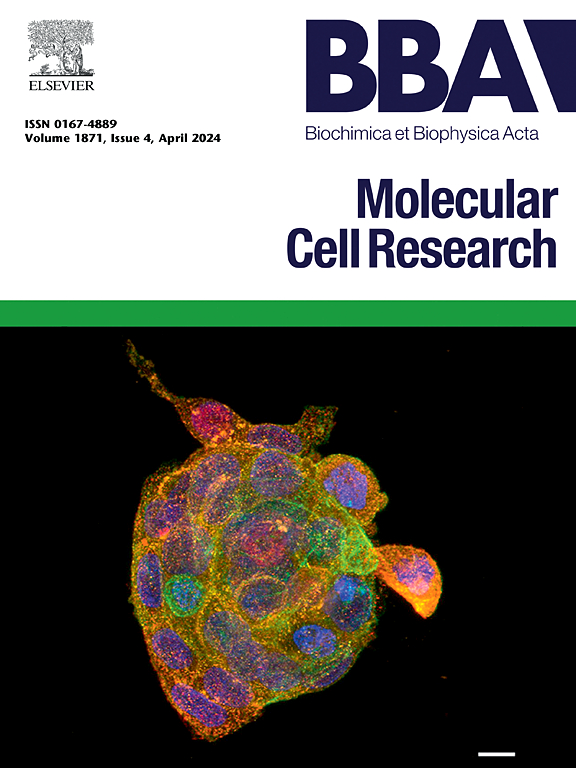TRIM40 与 ROCK1 直接相互作用,通过 c-Myc/p21 轴抑制结直肠癌细胞增殖。
IF 4.6
2区 生物学
Q1 BIOCHEMISTRY & MOLECULAR BIOLOGY
Biochimica et biophysica acta. Molecular cell research
Pub Date : 2024-09-30
DOI:10.1016/j.bbamcr.2024.119855
引用次数: 0
摘要
背景:大肠癌(CRC)是消化道最常见的恶性肿瘤,迄今为止,发病率和死亡率仍然居高不下。虽然现有的治疗方法取得了一定的疗效,但在治疗该疾病方面仍存在许多问题。因此,不断寻找 CRC 的新治疗靶点,从而开发出新的治疗方法,仍是当务之急:方法:采用免疫组化、Real-time PCR和Western Blot技术分别检测靶蛋白的mRNA和蛋白水平。采用 ATP 试验、软琼脂试验和裸鼠皮下肿瘤发生试验评估 CRC 细胞的增殖能力。蛋白质降解试验用于测定蛋白质的降解率,泛素化试验用于评估目标蛋白质的泛素化修饰水平。免疫沉淀试验用于研究蛋白质之间的相互作用,而牵引试验则用于研究蛋白质之间的直接相互作用:结果:TRIM40在CRC组织中明显下调,其表达水平与疾病预后呈正相关。体外和体内研究表明,TRIM40能明显抑制CRC细胞的增殖。分子机制研究表明,TRIM40 可直接与 ROCK1 蛋白结合并泛素化,加速其降解,进而降低 c-Myc 蛋白的稳定性。这一系列事件导致c-Myc释放对p21的转录抑制,导致p21表达增加,CRC细胞G0/G1期停滞:这项研究表明,TRIM40 可能是治疗 CRC 的一个有价值的治疗靶点。本文章由计算机程序翻译,如有差异,请以英文原文为准。
TRIM40 interacts with ROCK1 directly and inhibits colorectal cancer cell proliferation through the c-Myc/p21 axis
Background
Colorectal cancer (CRC) is the most common malignancy of the digestive tract, and to date, morbidity and mortality rates remain high. While existing therapeutic methods have achieved certain effective outcomes, there are still many problems in treating this disease. Therefore, it is still urgent to constantly find new therapeutic targets in CRC that could lead to new therapeutics.
Methods
Immunohistochemistry, Real-time PCR and Western Blot were employed to measure mRNA and protein levels of the target protein, respectively. The proliferation ability of CRC cells was evaluated using ATP assay, Soft agar assay, and nude mouse subcutaneous tumorigenesis assay. Protein Degradation Assay was conducted to determine protein degradation rate, while Ubiquitination assay was used to assess the ubiquitination modification level of target proteins. Immunoprecipitation assay was used to study protein interactions, and pull-down assay was employed to investigate direct interactions between proteins.
Results
TRIM40 was significantly down-regulated in CRC tissues, with its expression levels positively correlating with disease prognosis. Using both in vitro and in vivo approaches, it was demonstrated that TRIM40 could significantly inhibit the proliferation of CRC cells. Molecular mechanism studies showed that TRIM40 directly binds to and ubiquitinates ROCK1 protein, accelerating its degradation and subsequently reducing the stability of c-Myc protein. This cascade of events results in the release of transcriptional inhibition of p21 by c-Myc, leading to increased p21 expression and G0/G1 phase arrest in CRC cells.
Conclusion
This research suggests that TRIM40 could be a valuable therapeutic target for the treatment of CRC.
求助全文
通过发布文献求助,成功后即可免费获取论文全文。
去求助
来源期刊
CiteScore
10.00
自引率
2.00%
发文量
151
审稿时长
44 days
期刊介绍:
BBA Molecular Cell Research focuses on understanding the mechanisms of cellular processes at the molecular level. These include aspects of cellular signaling, signal transduction, cell cycle, apoptosis, intracellular trafficking, secretory and endocytic pathways, biogenesis of cell organelles, cytoskeletal structures, cellular interactions, cell/tissue differentiation and cellular enzymology. Also included are studies at the interface between Cell Biology and Biophysics which apply for example novel imaging methods for characterizing cellular processes.

 求助内容:
求助内容: 应助结果提醒方式:
应助结果提醒方式:


